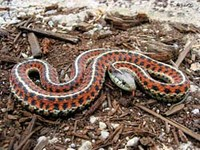Rutgers-Newark psychologist finds infants aren’t born afraid of spiders and snakes, but learn these fears quickly

Vanessa LoBue
LoBue, who recently joined the faculty of Rutgers-Newark, is a developmental psychologist. Her laboratory, which she’s currently setting up in Smith Hall, will differ from the stereotypical science lab in at least one respect: it will have plenty of open space for children to play and run around in.
“If you want to study how humans learn certain behaviors or abilities, the advantage of pursuing developmental psychology is that you can study how these behaviors originate in infants and children,” LoBue said. “And that really tells you about how a certain behavior originates.”
Her recent research project, which generated widespread press coverage last week, sought to probe the origin of two the most widespread phobias of humankind: fear of spiders and snakes.
“I think we all got into this work after observing how many people are afraid of snakes and spiders,” she said. “Considering that they aren’t very threatening to people (particularly in the United States), it’s strange and interesting that they make up two of the most common phobias throughout the world.”

In a paper published in the recent issue of Current Directions in Psychological Science, the journal of the Association for Psychological Science, LoBue and her colleagues conclude that humans aren’t born with an innate fear of spiders and snakes, but have the ability to quickly learn those fears.
The children tested in the study exhibited a “perceptual bias” toward snakes – essentially an ability to quickly detect them and to make connections, or associations between snakes and fearful voices.
The findings build on earlier work by other researchers that showed both human adults and monkeys learn to fear spiders and snakes more readily – and visually detect snakes and spiders more rapidly - than other displays of stimuli.
“What’s really new about this work is that we looked at children and what we found is the same sort of responding bias,” LoBue said. “This suggests that these biases are either learned in the first year of life, or they are present throughout life.”
In one experiment, the researchers showed infants as young as 7 months two videos side by side – one of a snake and one of something that’s not dangerous such as an elephant. Meanwhile, they played a recording of a fearful voice or a happy voice. The babies spent more time looking at the snake videos when listening to the fearful voices, but exhibited no fear themselves.
“This suggests they find something natural about the combination of the snake and something fearful,” said LoBue, who co-wrote the paper with David H. Rakison of Carnegie Mellon University and Judy S. DeLoache of the University of Virginia. “The implication is that this might help us learn to be afraid of snakes very quickly.”
In another study, 3-year-olds who were shown a group of photographs identified snakes more quickly than flowers and more quickly than other animals that look similar to snakes, such as frogs and caterpillars. Children who were afraid of snakes were just as fast at picking them out than children who hadn’t developed that fear.
Having established that infants and young children show the visual biases, LoBue said future research will test whether the biases can lead to the ability engage in defensive behavior or to make rapid decisions.
“The next step is to see how these biases lead to fear learning,” she said.